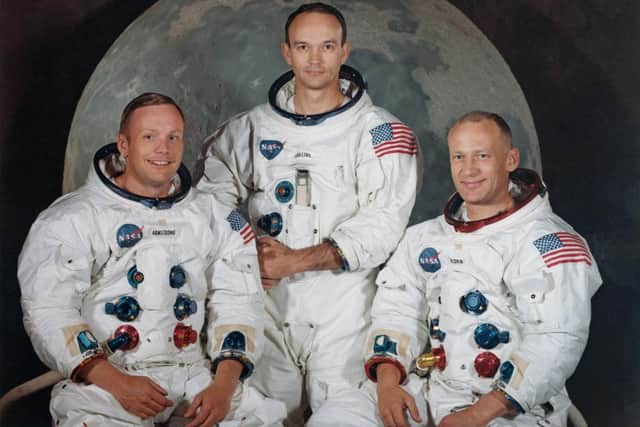Michael Collins: what was Apollo 11 mission - and who were fellow astronauts Buzz Aldrin and Neil Armstrong?
The world paid tribute to one of its great unsung heroes on Wednesday following news of the death of pioneering astronaut Michael Collins.
Along with Neil Armstrong and Buzz Aldrin he manned the first manned mission to the moon, piloting the ship from which Neil Armstrong and Buzz Aldrin left to make their historic first steps on the moon.
Advertisement
Hide AdAdvertisement
Hide AdWhile his crew mates landed on the lunar surface and sealed their place in the history books, Collins remained alone in the command module, Columbia.


The 28-hours that he spent alone in the spacecraft would no doubt have been frantic, for had something gone wrong and Mr Aldrin and Mr Armstrong been stuck on the moon’s surface — a real fear — Mr Collins would have returned to Earth alone.
Who were Michael Collins’ crew mates?
Neil Armstrong was the first human to set foot on the moon, closely followed by Buzz Aldrin.
Armstrong’s immortal words: "That's one small step for (a) man, one giant leap for mankind" upon stepping on the lunar surface became instantly iconic.
Upon his return to earth Armstrong said that he would not fly into space again, instead serving at NASA Headquarters as the deputy associate administrator for aeronautics.
Following his death in 2012 a family statement read: "Neil Armstrong was also a reluctant American hero who always believed he was just doing his job. He served his nation proudly, as a navy fighter pilot, test pilot, and astronaut.”
Aldrin is the only living Apollo 11 crew member. In 1966 prior to the Apollo 11 mission, Aldrin made a five-hour spacewalk the longest and most successful at that time.
Aldrin opened up on being labelled the second man to land on the moon in 2016, stating: “As the senior crew member, it was appropriate for [Neil Armstrong] to be the first.
Advertisement
Hide AdAdvertisement
Hide Ad"But after years and years of being asked to speak to a group of people and then be introduced as the second man on the Moon, it does get a little frustrating.
"Is it really necessary to point out to the crowd that somebody else was first when we all went through the same training, we all landed at the same time and all contributed?
"But for the rest of my life I'll always be identified as the second man to walk on the Moon.”
Following Apollo 11’s splashdown Aldrin would never return to space instead working in a managerial role with the US air force.
What was the Apollo 11 mission?
Apollo 11 was the first manned mission to the lunar surface.
On July 20, 1969, crew members Neil Armstrong and Buzz Aldrin became the first humans to land on another planetary body, and return to earth with samples from the lunar surface.
The flight was the culmination of the Apollo space program and saw the United States government achieve its goal of landing on the moon before Cold War nemesis the Soviet Union.
The eight-day mission was followed by a global audience of hundreds of millions.
Advertisement
Hide AdAdvertisement
Hide AdThe trio lifted off on July 16, reaching a maximum velocity of 25,000 mph, performing a circuit of earth before making a beeline for the lunar body.
Approximately 75 hours after liftoff the Apollo spacecraft entered the moon’s orbit, with Armstrong and Aldrin entering the lunar module some 25 hours later, leaving command pilot Michael Collins behind.
Two hours later Armstrong uttered the immortal words “the Eagle has landed”.
Armstrong then departed the lunar module and proclaimed "That's one small step for a man, one giant leap for mankind."
While on the surface the pair would take photographs, record their impressions of the landscape, collect piles of moon rocks and soil specimens, and deploy a package of scientific experiments, some which would stay on the moon after they left.
After a meal and a nap the duo made their return to the Apollo spacecraft in a nail-biting moment for the NASA team back on earth and Michael Collins who had spent 28 hours alone.
The three would reenter the earths orbit on July 24 and splashdown landing in the Pacific Ocean.